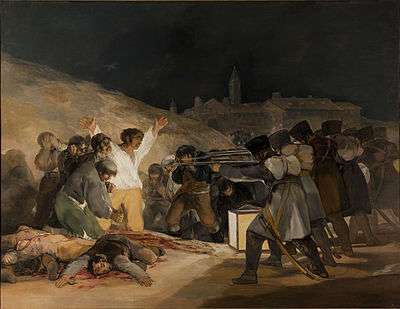History of Spain (1700–1810)
Spain entered a new era with the death of Charles II, the last Spanish Hapsburg monarch, who died childless in 1700. The War of the Spanish Succession was fought between proponents of a Bourbon prince, Philip of Anjou, and an Austrian Hapsburg claimant. With the Bourbon victory, Philip V's rule began in 1715. Spain entered a period of reform and renewal, as well as continued decline. Ideas of the Age of Enlightenment entered Spain and Spanish America during the eighteenth century. The invasion of the Iberian Peninsula by Napoleon Bonaparte in 1807–1808 upended political arrangements of the Spanish Empire and the Portuguese Empire.
Kingdom of Spain Reino de España | |||||||||||||
|---|---|---|---|---|---|---|---|---|---|---|---|---|---|
| 1700–1810 | |||||||||||||
Motto: Plus Ultra "Further Beyond" | |||||||||||||
 Territories that were ever part of the Spanish Empire during the Enlightenment. | |||||||||||||
| Capital | Madrid | ||||||||||||
| Common languages | Spanish, Catalan (including Valencian), Basque, Galician, Bable, Fala, Aragonese, Occitan (Aranese) | ||||||||||||
| Religion | Roman Catholic | ||||||||||||
| Government | Absolute Monarchy | ||||||||||||
| Monarch | |||||||||||||
• 1700–1724 (first) | Philip V | ||||||||||||
• 1808 (last) | Ferdinand VII | ||||||||||||
| Historical era | Enlightenment era | ||||||||||||
• Death of Charles II | 1 November 1700 | ||||||||||||
• Spanish War of Succession | 1700–1715 | ||||||||||||
| 1740–1748 | |||||||||||||
| 1756–1763 | |||||||||||||
| 1807–1814 | |||||||||||||
| 24 September 1810 | |||||||||||||
| ISO 3166 code | ES | ||||||||||||
| |||||||||||||
Bourbon monarchs, 1700–1810
Philip V, first Spanish Bourbon monarch (1715-46)
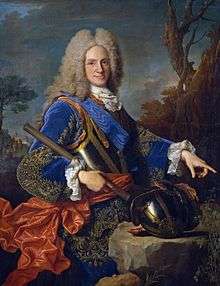
The last few years of the rule of the mentally challenged and childless Spanish Hapsburg Charles II, were dominated by the politics of who would succeed the unfortunate monarch, the last Spanish king of the Habsburg dynasty. Spain was at the center of this political crisis, but it was the "object not the arbiter."[1] Economic troubles, the decay of the Spanish bureaucracy, a series of defeats in wars against France, and the erosion of imperial institutions in the seventeenth century had left Charles the king of a declining empire, and his physical and mental weakness provided him with little ability to reverse the course of his country. The vastness of the Spanish Empire in the New World, along with her naval resources, had made Spain a vital part of European power politics. If the throne of Spain was to go to a relative of the king of France, or if the two countries were to be united, the balance of power in Europe might shift in France's favor. If it remained in the hands of another member of the anti-French, Austrian Habsburg dynasty, the status quo would remain. European politics during the seventeenth century became dominated by establishing an orderly succession in Spain that would not alter the balance between Europe's great powers. European powers, Bourbon France and Hapsburg Austria went to war to determine the successor to Charles. The War of the Spanish Succession was won by France, but in the Treaty of Utrecht, the French and Spanish Bourbon dynasties were not to unite. Philip V of Spain renounced any claims to the French throne.

Philip V proved an effective administrator, centralizing the Spanish authority by eliminating regional cortes (parliaments) and beginning a process of making uniform the laws among the various regions of Spain's empire by eliminating special privileges (fueros). His selection of capable French and Italian ministers to key positions in the government reined in independent, isolated, and corrupt ministries that had flourished in the later period of Habsburg rule. Philip aimed at expanding economic activity and moved toward economic freedom, especially regarding Spain's trade in its overseas empire, in theory a Spanish monopoly. Expanding Spanish manufactures and agricultural exports was envisioned, so that trade did not benefit foreign powers who had horned in on the Spanish American trade. The House of Trade long operating in Seville, was moved to Cádiz in 1717. Philip permitted the foundation of the Basque Caracas Company in 1728, on the model of Northern European trading companies, to trade with Venezuela, a major producer of chocolate.[2] The free trade zone (comercio libre) within the Spanish sphere expanded further with later Spanish Bourbons.
Philip – a manic depressive often dominated in his policies by his wife Elizabeth Farnese – adopted an aggressive foreign policy that invested Spain in a series of costly wars throughout his reign. The loss of so much of the European territory promised to him by Charles II's decree and Philip V's personal ambition put him at unease with the treaty. Philip's wife Elizabeth – a member of the ducal house of Parma – and her favorite minister, Cardinal Giulio Alberoni, desired to have their claims in Italy and those of Philip's restored. But an alliance of France, Britain, and the Netherlands challenged Spain's ambitions which threatened the peace of Europe. In 1717, Philip invaded Sardinia, one of the territories lost to Austria after the War of the Spanish Succession. The invasion of Sicily thereafter prompted the formation of the Quadruple Alliance of Britain, France, Austria, and the Netherlands to oppose Philip's ambitions. In 1720, embarrassed by the failure of Spanish arms at sea and on land in the War of the Quadruple Alliance, Philip dismissed Alberoni and signed a peace treaty with Austria, with both sides recognizing the Treaty of Utrecht.
The Spanish again attempted to regain some of their lost territory in the Anglo-Spanish War of 1727–1729. An alliance was concluded in 1725 with the Austrians, who agreed to help the Spanish in retaking key naval bases in the Mediterranean - Menorca and Gibraltar – from the British.

In response, an alliance was forged by the British Secretary of State, Charles Townshend, 2nd Viscount Townshend, with France and the Netherlands; when Philip did finally lay siege to Gibraltar, Austria declined to intervene against the powerful alliance, and Spain was left alone once again. French armies invaded the Basque country and Britain and Netherlands elected to devastate Spain's New World empire and disrupt precious metal shipments hoping to prevent Philip from buying the Austrians into intervention; the allies suffered greater losses in men than the Spanish but the plan succeeded and Philip was forced to sue for peace in 1729. Elizabeth Farnese did get one of her wishes, though; the Italian duchies of Parma, Piacenza, and Tuscany were restored to her family.[3]
After 1729, Philip was more reserved in his use of Spanish power and sought the close support of allies, in particular France: a more cautious strategy that yielded positive results. Philip sought a friendly axis with his relatives in France in the War of the Polish Succession, where he succeeded in regaining Naples and Sicily for his son, the future Charles III of Spain. The Family Compact with Louis XV of France was signed in 1733, bringing the two states closer together after the embarrassments of the Quadruple Alliance. Friction with Britain prompted by the War of Jenkins' Ear (1739–1741) pushed Philip into a closer alliance with France in the years leading to the War of the Austrian Succession, in which Philip obtained further concessions from Austria for his family in Italy. This restored Spanish power in Italy to much of its pre-war extent, and added new territories that had not previously been part of the Spanish Empire in Italy.
Late in his reign, Philip elected to place the reformation of his government in the hands of his ministers. The youthful and ambitious Zenón de Somodevilla had been created Marquis of Ensenada in 1736 for his successful diplomacy after the War of the Polish Succession, and seven years afterwards, in 1743, he was made Philip (and Elizabeth's) favorite at court, and for the remainder of Philip's reign, Ensenada effectively ruled Spain. Ensenada sought a cautious but independent foreign policy that distanced his country from both France or Britain, and desired a stable, peaceful environment in which Spain could reform her institutions.
Ferdinand VI (1746–59)
.jpg)
The end of the War of the Austrian Succession had awarded Ensenada a victory that cemented his support in Spain. However, two years before the war ended, King Philip, his strongest supporter, died, and was succeeded by his son Ferdinand VI. Ferdinand was Philip's son by his first marriage to Princess Maria Luisa of Savoy; he had suffered under the domineering influence of his stepmother as a child, and as king, he was constantly unsure of his own abilities. Elizabeth Farnese, the queen who had effectively controlled Philip V, left the court on her husband's death. Like his father, Ferdinand was extremely devoted to his wife, and she dictated much of his policy and political decisions; at the time of Ferdinand's coronation in 1746, it was said that "Queen Barbara has succeeded Queen Elizabeth." For her part, Queen Maria Barbara de Braganza, a member of the Portuguese royal family, advocated a policy of neutrality that coincided with the opinions of her leading courtiers, far different from the irredentist policy of Elizabeth.
Ferdinand's rule reaped good fortune and the rewards of Philip V's reforms. He was a charitable ruler, relieving drought-stricken Andalusia from all taxes in 1755 and devoting large sums of money to the reconstruction of that part of the country. As king, he deferred many of his judgments to his leading ministers.
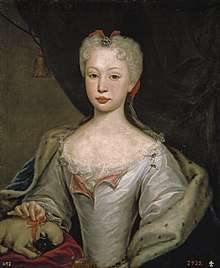
Ensenada continued to be the leading member of court in the early part of Ferdinand's reign. After the successful alliance with France in the War of the Austrian Succession, he advised strengthening that bond as a means of protecting Spain's vulnerable security and checking British interests in her empire. He was opposed by an anglophile faction at court led by Jose de Carvajal y Láncaster, a mixed British-Spanish gentleman descended from the House of Lancaster. Carvajal believed that the key to Spain's defense and modernization was a closer alliance with Britain, whose naval power could complement Spain's empire and whose commercial strength could encourage economic development in Spain. Carvajal's most enduring accomplishment was the 1750 agreement with Portugal, which ended a long, low-level conflict in Banda Oriental (southern Uruguay) between the two countries.

The agreement with Portugal, however, was to have important political consequences for Spain. The agreement traded seven Jesuit-established and -operated missions in southern Uruguay for Portuguese-founded and -controlled Uruguay. The plan (opposed by both the Jesuits and the British) led to resistance led by the Jesuits and their native Guaraní allies in the area. Both Spain and Portugal responded in force to the crisis, suppressing the Jesuits and Guaraní in the War of the Seven Reductions. The war broke a traditionally friendly relationship between the Spanish government and the Jesuits and launched a period of anti-Jesuit policies both in Spain and Portugal that would be continued by Charles III of Spain.
A scandal at court, resulting from a conspiracy between Carvajal and the British ambassador, led to the embarrassment of Ensenada and his disrepute at court. When Carvajal died in 1754, Ferdinand and his wife dismissed Ensenada, fearing that the Marquis's French sympathies would lead to an alliance with Louis XV of France and war, without Carvajal's British sympathies to counterbalance him. An Irishman, Ricardo Wall, was appointed to replace Ensenada as chief minister. Wall, a staunch defender of Spain's neutral policy, successfully kept the country out of war for the remainder of Ferdinand's reign, in spite of the outbreak of the largest European war since the Thirty Years' War, the Seven Years' War.
Although his wife had always feared that Ferdinand would die before her and leave her destitute – she had amassed huge personal wealth as a safeguard against this – it was his wife Maria Barbara who would precede him, dying in 1758. Deeply distraught by her death, Ferdinand became apathetic to his duties as king, and indeed, suicidal. He died a year later, in 1759.
Charles III and Enlightened despotism (1759–88)
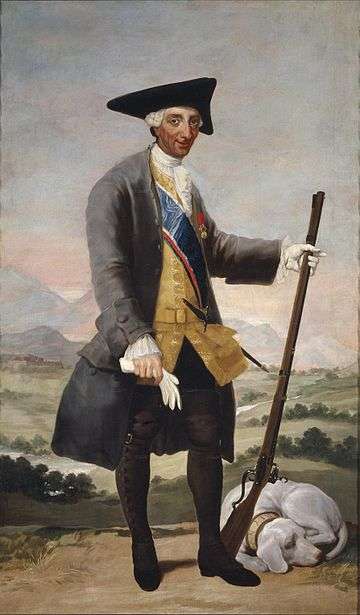
Ferdinand's successor was Charles III, son of Philip V by his second wife, Elizabeth Farnese. Charles was the half-brother of Ferdinand VI, and considered "the most successful monarch of Spain after Ferdinand and Isabel" in the late fifteenth and early sixteenth centuries. "He deserves high a rank among the enlightened despots of the eighteenth century, for in many ways he accomplished more than such famous rulers as Frederick the Great of Prussia, and Joseph II of Austria."[5] Charles had been named Duke of Parma at his mother's demand at the age of sixteen. His experience there gave him a place to experiment with the practice of enlightened despotism. He exhibited a martial spirit early on, acquiring Naples and Sicily by force of arms and becoming "King of the Two Sicilies," though his tastes were generally more peaceful. On arriving in Spain, he did not share Carvajal's taste for an alliance with Britain; he had borne the island nation a certain mistrust ever since a British fleet had forced his neutrality in the War of the Austrian Succession.
He had been introduced to reform by his mentor in Sicily, Bernardo Tanucci. Although Tanucci remained behind in the Two Sicilies to advise Charles's son, King Ferdinand I of the Two Sicilies, as the two thrones could not be united by consequence of treaty, Charles carried with him a cadre of Italian reformers who saw potential in the Spanish bureaucracy for modernization. The architect of the first phase of Charles III's reforms was one such Italian, Leopoldo de Gregorio - a man of humble origins whose ability as a military supplier for the Neapolitan army impressed the king and raised him to royal prominence. Created "Marquis of Esquilache" in 1755, Gregorio was one of Spain's leading statesman from the arrival of Charles III to the Marquis's death in 1785.

Although the Seven Years' War had broken out in 1756, Spain had managed to remain strictly neutral under the ministry of Ricardo Wall, who continued to lead Spain's government in the early years of Charles III. Charles, however, bore a grudge against the English and as the war became increasingly desperate for France, he went against his chief minister's wishes and intervened on France's behalf in 1762. Spain fared poorly in the war, and the British briefly occupied Havana and Manila within a year. Florida was ceded to the British and Spain recognized British control over Menorca and Gibraltar in 1763, although the vast territory of Louisiana was given to Spain to compensate her for her losses. After the Treaty of Paris (1763), however, Spain could focus on internal development.
By far the largest landholder in Spain, the Church had been treated with great charity by the Spanish kings of the seventeenth century - Philip IV in particular donated large tracts of territory in religious piety. Much of this land went unused, and a great deal of the remainder of the country was owned by gentlemanly hidalgos who lived primarily off of the state. The system had grown long obsolete, and a growing population (Spain's population would increase from eight to twelve million between 1700 and the French Revolution) had put great pressure on the government to reform. Like neighboring Portugal, Spain's antiquated bureaucracy had grown dependent on the income and production from its colonies to support an unmanageable, large class of landowning, nonproductive gentlemen and clergy.
The Enlightenment had been a force of anticlericalism in Europe, and Charles, in applying its lessons to Spain, saw it less stridently, seeking to strengthen the power of the crown (regalism) against that of the Catholic Church and the papacy. Ferdinand VI had undertaken to reduce the power of the Jesuits in Spain and had arranged for Spain's kings to appoint her own bishops, a power that France's kings had held since the fifteenth century. Charles, who advocated a radical policy and rapid modernization of the country, expelled the Jesuit Order from Spain completely in 1767 (see Suppression of the Jesuits). The Inquisition was scaled down, but not completely eradicated; as late as 1787, a woman was burned as a witch.
Land reform and agricultural reform alienated both clergymen and landed elites in Spain. Charles chose to ally with the merchantmen of his country and a growing middle class that came with a new prosperity during his rule. An advocate of free trade, Charles reduced the tariff barriers that had been the core of Spanish trade policy for centuries. The Marquis of Esquilache successfully liberalized the grain trade in 1765, but riots broke out in 1766 in due to the rise in grain prices.
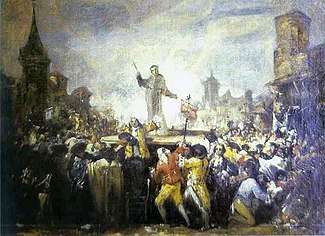
Although he believed in centralized government and continued the reforms of his predecessors to reduce the autonomy of the regional parliaments that could potentially challenge his power, Charles approved of establishing prototype chambers of commerce, the Economic Societies of the Friends of the Country) to encourage local economic development and initiative. The national infrastructure was improved to foster the development of Spanish manufacturing, and a unified monetary system was implemented.

The reforms were not without costs, however, and in 1766, in the context of a worldwide grain shortage and the difficulties of the recently liberalized grain trade, riots broke out in Madrid and other cities in Spain against rising grain prices. The "Motin de Esquilache" drove the king from his capital and embarrassed the king's chief minister. Aragonese grandee, the Count of Aranda. Aranda gained prominence during the crisis and led the government in the king's absence. Aranda was the only titled aristocrat in Charles's administration; the king generally preferred men of lower social origin who were university graduates from outside Castile. Charles granted noble titles to able men in his administration, who became part of a loyal and progressive bureaucracy.[6] Charles removed Esquilache from power in Madrid, naming Ambassador to Venice.
Aranda, as the leader of the Aragonese faction at court, favored a more decentralized system of government. Following the ouster of Esquilache for a time Aranda was the leading figure in Spanish politics. A criminal prosecutor named José Moñino gained prominence as the investigator of the riots and as an outspoken supporter of the king's reformist policies. The riots were attributed to the Jesuits, who were advocates of papal power, when Bourbons were centralizing regal power. The role of the Jesuits in the riots was named as the reason to oust the Jesuits from Spain and its empire in 1767. Esquilache had arranged to have him made ambassador to Venice in 1767; in 1773 Moñino succeeded in having the Pope revoke the papal charter of the Jesuit Order. For this success, Charles named Moñino the Count of Floridablanca.
The new count was named chief minister in 1777 and undertook the material reform of the Spanish bureaucracy. His chief bureaucratic successes were the creation of a true cabinet system of government in 1778 and the creation of Spain's first national bank, the National Bank of San Carlos, in 1782.[7][8] Recognizing the damage done to Spain's education system after the expulsion of the Jesuits, Floridablanca undertook drastic reform to hire new teachers and modernize Spain's education system. Floridablanca's most enduring accomplishment was the freedom of trade in Spain's empire in the New World to foreigners.
Although Floridablanca – like Carvajal before him – admired British governance and believed that a cordial relationship with George III of the United Kingdom was the best policy for Spain, the American Revolutionary War was too great an opportunity for Charles III to pass up, and Spain went to war against Britain alongside France and the Netherlands in 1779, after providing monetary assistance to the rebels. Bernardo de Gálvez, the governor of Spanish Louisiana, led the campaign to retake the forts lost to the British since 1762; Pensacola, Florida was retaken in 1782, and the Bahamas were seized later that year. The Treaty of Paris (1783) restored much of what Spain had lost in the Seven Years' War, including Florida.
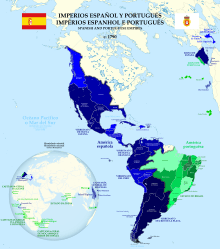
Charles IV, decline and fall, 1788-1808
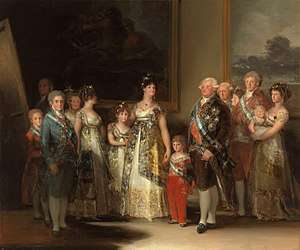
King Charles III died on 14 December 1788 and was succeeded by his son, Charles IV. Seven months later, French revolutionaries stormed the Bastille, launching the French Revolution. In its aftermath with the rise of Napoleon Bonaparte, Spain felt the impact of the changed circumstances of France.
Charles III's eldest son was both epileptic and mentally disabled and was passed over for the throne in favor of his second eldest, Charles IV. Charles IV was seen by many of his time as being as uninterested in politics just as Ferdinand VI had been. After growing up in Naples, Charles arrived in Spain, with his chief interest being hunting. For all of his rule, his policies were dominated by the will of his wife, Maria Luisa of Parma.[9] Charles retained many of the ministers who served his father, but Charles and Maria Luisa fueled the rise of Manuel Godoy, a humble military officer who became the monarchy's favorite, becoming chief minister in 1792.
.jpg)
The chief minister at the time of Charles IV's accession, José Moñino, count of Floridablanca, was not easily ousted and had many supporters in the court, particularly in Castile. Floridablanca's chief opponent in Spanish politics was Pedro Pablo Aranda, the leader of the Aragonese faction. Godoy made an alliance with Aranda, with whom Godoy sympathized, against Floridablanca. With the outbreak of the French Revolution and the execution of Louis XVI in 1792, Floridablanca's liberalism faced greater skepticism. Aranda and Godoy had Floridablanca imprisoned in 1792 on charges of embezzlement, of which he was later acquitted.

The spirit of reform that had made the reign of Charles III an era of renewed prosperity for Spain was extinguished in the reign of Charles IV. His queen and her lover were uninterested in the improvement of the Spanish bureaucracy and regarded Floridablanca as an exponent of the very sort of liberalism that was tearing France apart. The Aragonese faction led by Aranda, allied to many of the causes that had opposed Charles III's reforms, managed to undo much of the changes brought about in Charles III's tenure.
After the execution of Louis XVI in 1793, 20,000 men were mobilized and marched to the French border. The army, however, had been allowed to languish in Charles III's reign, and it was ill-equipped and ill-trained to cope with a French invasion. Navarre was quickly seized by the French, although the Spanish managed to hold their ground in Catalonia and even invaded French Languedoc. Godoy, unimpressed with Spain's military effectiveness, decided to come to terms with the new French Republic, and in 1795 signed the Treaty of Basel, guaranteeing peace with France with the cession of Santo Domingo to the Republic.
Godoy, having abandoned his allies in the United Kingdom and Austria, faced a decision: whether to continue to fight the Revolutionary France that had already defeated Spain once before, or to join the French side and hope for better times. The Spanish, after initially opposing the French, signed the Treaty of San Ildefonso in 1796, allying Spain to France, in exchange for French support for Charles IV's relations ruling the Italian duchy of Parma. In response, the British blockaded Spain in 1797 and separated her colonial empire from the mother country. By the end of 1798, the Spanish fleet had been defeated by the British, and Menorca and Trinidad were occupied. In 1800, the Spanish returned Louisiana to France, which had been given to them in compensation for their losses at the end of the Seven Years' War.
The Portuguese, who opposed the French, continued to trade with the British in spite of a series of French demands that they close their ports to British ships. In 1801, the Spanish delivered an ultimatum on behalf of France, and in the following border war, occupied the town of Olivenza (Olivença) before the Portuguese agreed to the Spanish and French demands. The town – which is disputed to the present day – continues to be administered by Spain though Portugal contends that the Congress of Vienna restored it to Portugal.
The Treaty of Amiens in 1802 provided for a temporary truce in hostilities, only to be broken in 1804 when the British captured a Spanish treasure fleet off Cádiz. The French planned an invasion of England in the coming year; the Spanish fleet was to be an integral part in assisting this invasion. At the Battle of Trafalgar in 1805, the Spanish navy and the French Mediterranean fleet, attempting to join forces with the French fleets in the north for the invasion, were attacked by Admiral Lord Nelson at the head of a British fleet in one of history's greatest naval engagements. The disastrous defeat that the Spanish and French suffered assured British dominance at sea and seriously shook the resolve of the Spanish who began to doubt the usefulness of their always mutually suspicious alliance with Napoleon's regime.
After Trafalgar, Godoy withdrew from the Continental System that Napoleon had devised to combat Britain, only to join it again in 1807 after Napoleon had defeated the Prussians. Napoleon, however, had lost his faith in Godoy and King Charles; there was also growing support in Spain for the king's son, Ferdinand, who opposed the popularly despised Godoy. Ferdinand, however, favored an alliance with Britain, and Napoleon, always suspicious of the Bourbons, doubted the trustworthiness of any Spanish royalty.
Ferdinand VII and the Napoleonic upheaval, 1808-1814
%2C_When_Prince_of_Asturias_MET_DT236256.jpg)
In 1808, Spain and France agreed to the partition of Portugal, which had renewed its support of the British after Trafalgar. The French and Spanish quickly occupied the country. Prince Ferdinand traveled to France, and rumors spread that he was asking for Napoleon to oust Godoy from power; the Spanish King sided with his favorite. Riots broke out in various parts of Spain, and in the Tumult of Aranjuez, Godoy was arrested and Charles IV forced by his son and heir Ferdinand to abdicate in Ferdinand's favor. Napoleon, however, had lost confidence in the Spanish monarchy and when Ferdinand traveled to France to obtain the French emperor's support, Napoleon pressured Ferdinand to abdicate in favor of his father Charles IV, who had abdicated under pressure. Charles IV himself abdicated in favor of Napoleon, since he did not wish his detested son to return to the throne. Napoleon then placed his older brother Joseph Bonaparte on the throne. As a way to legitimize the transfer of power, Napoleon summoned a group of Spanish aristocrats to Bayonne, where they signed and ratified the Bayonne Constitution on 6 July 1808, Spain's first written constitution. The Spanish chose to resist.
Peninsular War against the French (1808–14)
The Spanish people rallied around the cause of Prince Ferdinand, who, even as a prisoner in France, was made into a national hero in what became a "war of independence" for Spain. Godoy, Charles IV, and his wife retired first to France, then to Italy, and left Spanish politics permanently.[10]
The installation of Joseph Bonaparte as King of Spain sparked a revolution in Spain. On the 3 May 1808, a revolt in Madrid was bloodily suppressed by the French army, which now found itself attempting the occupation of both Portugal and Spain. The incident and the perceived brutality of the French response created a rallying point for Spanish revolutionaries; the executions were captured famously by the Spanish painter Francisco Goya. The Spanish army, on the whole, pronounced itself in favor of Ferdinand and joined the British and Portuguese in a united front against the French.

Regional juntas were set up that declared Joseph's monarchy invalid; the clergy rallied against the "godless" French. The juntas collectively asked Britain for aid, and London was only too happy to oblige. The Junta in Seville declared itself the Supreme Junta for Spain in 1808, and most regional juntas (and the colonies in the New World) assented to the supremacy of the Seville Junta, which became a provisional government for Spain in the absence of Ferdinand. A new French offensive the following year forced it to withdraw to Cádiz, where it would remain until close to the end of the war.
King Joseph had attempted to reconcile with the Spanish early on; at Bayonne, after the forced abdication of Ferdinand, Joseph gathered an assembly of Spanish notables to draft a constitution for his new Bonapartist regime in Spain. The most prominent members in Spanish politics – including the Count of Floridablanca – declined to attend. The cabinet and constitution that Joseph did present was viewed as illegitimate. Joseph entered Madrid on 25 July 1808, after the rebellion against his government was already well under way.
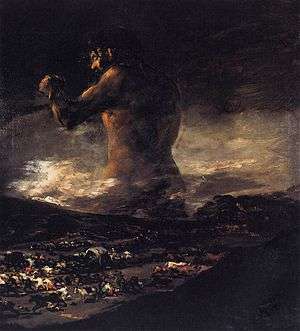
A series of victories against the French in 1808 prompted Napoleon himself to invade Spain in 1809, forcing the British and their allies to evacuate the peninsula in only two months' time. Satisfied, Napoleon placed command of the war in the hands of one of his marshals, Nicolas Jean de Dieu Soult. With the destruction of the Spanish army in 1808, Spanish resistance transformed into fierce guerrilla warfare. Although numerically superior to the regular British, Portuguese, and Spanish armies, so effective were the Spanish guerillas that of 350,000 men of the French Armée de l'Espagne, 200,000 were employed in the protection of France's vulnerable lines of supply stretching across the breadth of Spain.
Many Spanish liberals – carrying the tradition of Charles III and his ministers – saw in a close relationship with France the hope for modernity and progress in their country. Called "afrancesados," they viewed the end of the Inquisition and the establishment of a more secular, liberal monarchy with affection, but as the French occupation dragged on, popularity for French rule even among liberals waned. By 1812, many of these afrancesados had become members of the Spanish guerilla war.
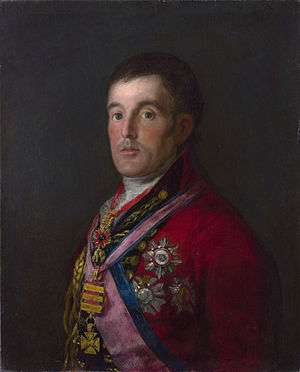
The British, under the command of Sir Arthur Wellesley, invaded Spain from Portugal in 1810. A Spanish force, pulled together from the remnants of the Spanish army and volunteer fighters, joined him and successfully defeated the French under the personal command of Joseph Bonaparte at the Battle of Talavera. For his victory, Wellesley was made Duke of Wellington, although not long after Talavera he was forced to retreat into Portugal once more. Although Wellington took Madrid on 6 August 1812, he retreated not long after back to Portugal. With the stretched and harassed French forces depleted when Napoleon redeployed troops for what would be a disastrous offensive against Russia, [[saw an opportunity and attacked again in 1813. At the Battle of Vitoria, on 21 June 1813, the French under the personal command of King Joseph were again defeated, and were subsequently forced as far back as the Pyrenees in early July. Fighting continued in the mountains throughout the winter, though in the spring of 1814 the Allies advanced into southern France.
Cortes of Cádiz
The Cortes of Cádiz drafted the Spanish Constitution of 1812. Dominated by liberal reformers, the Cortes of Cádiz described a constitutional monarchy. The inquisition would be abolished, though Roman Catholicism was still the state religion and heresy a crime. The constitution provided for freedom of speech, freedom of association, and universal manhood suffrage. In response to the constitution, France temporarily annexed Catalonia.
References
- John Lynch, Bourbon Spain, 1700–1808. Oxford: Blackwell Publishers 1989, p. 22.
- Herr, "Flow and Ebb" p. 184.
- Simms, Brendan. Three Victories and a Defeat: The Rise and Fall of the First British Empire. Penguin Books, 2008. p.211
- Herr, Spain, p. 51
- Richard Herr, Spain, Englewood Cliffs, NJ: Prentice-Hall Inc., 1971, p. 51.
- Her, Spain, p. 59.
- Carlos Marichal, "Banco de San Carlos (Spain)" in Encyclopedia of Latin American History and Culture, New York: Charles Scribner's Sons, 1996, vol. 1, p. 278.
- Earl Hamilton, "Plans for a National Bank in Spain, 1701–1783" in Journal of Political Economy, 58, no. 3 (1949): 315–36.
- Payne, History of Spain and Portugal (1973) 2:415–21
- Payne, History of Spain and Portugal (1973) 2:422–28
Further reading
In English
- Elliott, John H. Empires of the Atlantic World: Britain and Spain in America 1492–1830 (2007)
- Herr, Richard. The Eighteenth-Century Revolution in Spain. Princeton: Princeton University Press 1958.
- Kamen, Henry (2001). Philip V of Spain : the king who reigned twice. New Haven : Yale University Press. ISBN 0-300-08718-7
- Lynch, John. Bourbon Spain 1700–1808 (1989)
- Noel, C.C. "Opposition to Enlightened Reform in Spain: Campomanes and the Clergy, 1765–1775." Societas 3, 1 (1973) pp. 21–43.
- Paquette, Gabriel B. Enlightenment, Governance, and Reform in Spain and Its Empire, 1759–1808 (2007)
- Walker, Geoffrey J. Spanish Politics and Imperial Trade, 1700-1789. Bloomington : Indiana University Press, c1979.
In Spanish
- Anes Alvares, Gonzalo. Economía e Ilustación en la España del siglo XVIII. Barcelona 1969.
- Egido Martínez, Teofanes (2001). Carlos IV. Madrid : Arlanza Ediciones. ISBN 84-95503-22-0
- Fernandez, Roberto (Fernandez Diaz) (2001). Carlos III. Madrid : Arlanza Ediciones. ISBN 84-95503-21-2
- Guimera, Agustín (1996). El reformismo borbonico : una visión interdisciplinar. Madrid : Alianza : Consejo Superior de Investigaciones Científicas. ISBN 84-206-2863-8
- Rodríguez Díaz, Laura. Reforma e Ilustración en la España del siglo XVIII. Pedro Rodríguez de Campomanes. Madrid, 1975.
- Santos, José (2002). Martín Sarmiento : Ilustración, educación y utopía en la España del siglo XVIII. La Coruña: Fundación Barrié de la Maza. ISBN 84-9752-009-2
- Sellés, Manuel, José Luis Peset, and Antonio Lafuente, eds. Carlos III y la ciencia de la ilustración. Madrid: Alianza Editorial 1988.
- Ubieto Arteta, Antonio (1997). Historia ilustrada de Espana, v. 5: El Barroco espanol y el reformismo borbonico. Madrid : Debate ; Valencia : Circulo de Lectores. ISBN 84-226-6342-2
- Ubieto Arteta, Antonio (1997). Historia ilustrada de Espana, v. 6: Guerra, revolucion y Restauracion. 1808–1833. Madrid : Debate ; Valencia : Circulo de Lectores. ISBN 84-226-6343-0
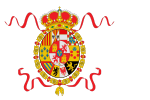
_Version_with_Golden_Fleece_and_Order_of_Charles_III_Collars.svg.png)

